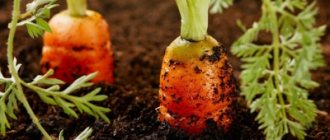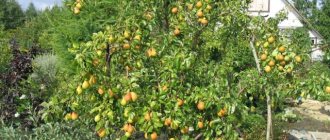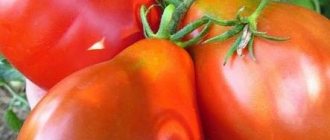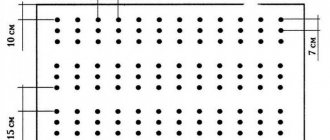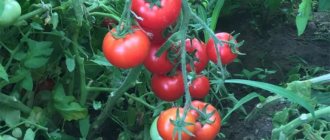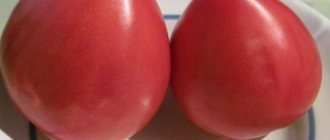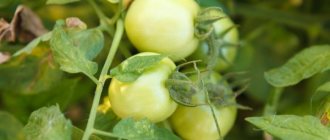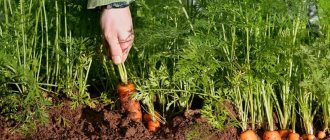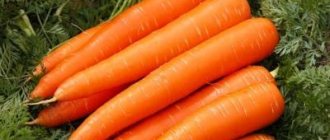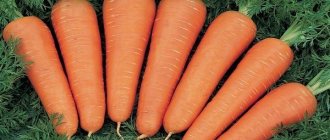Characteristics and description of the Red Giant variety
The carrot variety Red Giant is a translation from the German name ROTE RIESEN, a variety of German breeders.
- Appearance. The root crop is a conical, elongated shape that tapers to a pointed tip. The length of the carrot is 22-24 cm, thickness 4-6 cm. The root vegetable itself is orange-red in color and has a medium-sized core of the same color. The leaves of this carrot are very long, medium-dissected and dark green in color. The variety is not prone to shooting arrows and does not crack.
- Which variety does it belong to? Red Giant belongs to the Flakke (Valeria) variety. These are late-ripening carrots, suitable for long-term storage (read about late-ripening, early-ripening and mid-ripening varieties of carrots in a separate article).
- Amounts of fructose and beta-carotene. The root vegetable contains in 100 g:
- fructose – 7-8.8%;
- carotene – 10-12 mg.
- Sowing time. In spring, carrots are sown in April-May at a minimum soil temperature of +10 degrees Celsius. Pre-winter sowing is carried out in the fall at a temperature of +5 degrees Celsius. The germination rate of seeds of this variety is 70%. Germination period is 5-25 days.
- Average weight of 1 root vegetable. Its average weight is 150-180 g, and can reach up to 200 g.
- What is the yield from 1 hectare. The Red Giant carrot has a high yield of 300-500 c/ha.
- Purpose of the variety and keeping quality. This carrot variety can be used:
- fresh;
for salads;
- juice preparation;
- for freezing in grated form.
- Growing regions. The root crop is grown in most regions of Russia.
- Where is it recommended to grow? The variety is recommended by breeders for cultivation in the ground in the open air.
- Resistance to diseases and pests. It is highly resistant to diseases and pests.
- Maturing period. The ripening period ranges from 120 to 160 days depending on weather conditions, soil composition and moisture.
- What types of soil does he prefer? The Red Giant prefers loam and sandy loam soil. Slightly acidic soils are well suited.
- Frost resistance and transportability. The variety has excellent frost resistance and good transportability.
- Manufacturability of the variety for farmers and peasants. The Red Giant carrot variety is highly adaptable for cultivation by farmers and peasants. Modern technologies for cultivating this crop, harvesting and storing the crop have been developed. Convenient to clean and process for culinary purposes.
Has excellent keeping quality. If stored properly, the root crop can be used until the end of spring.
Main characteristics of the variety
Despite complaints and negative reviews, Rothe Riesen carrots are considered one of the most popular late varieties. Root crops take a really long time to ripen - about 4 months: from May to August or even the beginning of autumn. But the patience of summer residents is rewarded with a good harvest. From 1 sq. m you can dig up to 3.8 kg of carrots.
Red Giant root vegetables have the following characteristics:
- length – up to 20-25 cm;
- diameter - about 6 cm;
- shape - an elongated cone, the end of which is blunt;
- core – medium size;
- color – red-orange;
- weight – up to 150 g, on average – approximately 90-100 g.
Carrot seeds Red giant
The variety is resistant to many ailments and pests. Rote Riesen is considered a cold-resistant carrot, so some gardeners plant it not only in the spring, but also before winter.
Attention! The peculiarity of the Red Giant is its tall and thick tops. Therefore, it is not recommended to sow it densely.
Advantages and disadvantages
The advantages of the Red Giant carrot variety are:
- high productivity;
- sweet and juicy;
- possibility of long-term storage while maintaining taste;
- excellent keeping quality;
- the variety is resistant to diseases and pests;
- versatility in use.
The disadvantages are:
- long ripening of root crops;
- demanding attitude to moisture;
- low seed germination.
What are the good things about Rote Riesen carrots and what are their disadvantages? Reviews
Summer residents who have already appreciated the benefits of the Red Giant note that this carrot:
- very tasty, sweet and juicy. It makes good juice;
- germinates well, even when sown before winter;
- perfectly stored in the cellar, maintaining freshness;
- gives a good harvest;
- has very large sizes. Root crops are even and neat;
- It does not require special care;
- universal in use.
At the same time, there are also not very positive opinions about the Rote Riesen variety.
Carrot Red Giant
Gardeners disappointed with these carrots say:
- germination rate may be far from 100%;
- Root crops take a long time to ripen;
- the size of carrots is comparable to the harvest of other varieties, and if it exceeds them, then not by much;
- Red giant is more suitable for storage in the basement and consumption in winter and early spring. For the summer-autumn period, you can choose other, more tasty and early varieties.
Advice. In reviews, summer residents usually note which company’s seeds they purchased. Sometimes this information can be found out from a photo of the packaging - people often supplement their written opinions with it. Read which manufacturer gardeners trust more than others. The seeds of this company are unlikely to disappoint you if they have already gained a positive reputation among other gardeners.
Growing
The optimal temperature at which the seeds of the Red Giant will sprout is +10 degrees Celsius.
For sowing, it is best to choose sandy loam soil with low acidity. Before planting, the area is fertilized with humus. The variety is demanding on soil looseness; it must be carefully prepared. A feature of sowing root crops is the increased distance between seeds - 4-5 cm.
Caring for the Red Giant involves regular watering. 14 days after the sprouts appear, the first thinning is done. The second is done when the diameter of the young carrots becomes about 2 cm.
Growing the variety
The Red Giant variety prefers a sunny place.
Sandy loam or light loamy soil with a deep arable layer that is capable of permeating moisture is suitable. To give the soil such features, add a little sand. Carrots grow well in areas where cabbage, onions, tomatoes, early potatoes, and cucumbers were grown last year.
You should start preparing the land in the fall: dig it up, remove old roots and stones. You need to repeat the same procedure in the spring before planting. Next, the soil is fertilized with a solution of nitrate or urea. It is recommended not to use organic fertilizer in the form of manure, because it provokes distortion of the shape of root crops.
Sowing is done in late April - early May, when the soil can warm up to 10°C. Some sow carrots at 4°C, since the variety is known for its resistance to cold. For better germination, seeds are placed on damp gauze in a cool place for a week.
Sweet and juicy carrots
The beds are prepared shallow, on average 2-3 cm, at a distance of 20-30 cm from each other. Water them with a small amount of warm water, which should settle. When the moisture is absorbed, sow the seeds at a distance of 4-7 cm. Sometimes, to maintain the gap, they are glued to adhesive tape in advance, which will not prevent the sprouts from sprouting in the future. Fill the beds with soil, but do not water them - this can cause crust formation and make it difficult for seedlings to germinate.
Features of care
- For active carrot growth, weeds are regularly removed as they appear. Sometimes this action is carried out even before germination of the seedlings. Harmful plants remaining in the garden can damage root crops, taking away all the beneficial substances from the soil.
- Wanting to get large fruits, thin out the rows of carrots after the first pair of true leaves appear. Maintain a distance not exceeding 4 cm. The second thinning is carried out when there are two pairs of true leaves, increasing the perimeter by 2 times.
- Loosen the soil to allow air and water to reach the plant's root system. In addition, the crust formed on the surface of the soil provokes the curvature of root crops even while maintaining a large mass. Hill up the rows of carrots after the rain to prevent the peeking out tops from turning green due to subsidence of the soil.
Watering and fertilizing
It is better to water Rote Riesen every day, especially during drought, but in small quantities. The depth of moisture is directly related to the size of the root crops. Insufficient water will cause the carrots to become bitter and lethargic, and overwatering will cause the roots to crack.
Nutrients should be added to maintain the growth and development of the Red Giant twice during the growing season. The first feeding is carried out 3-4 weeks after the appearance of sprouts, the second – after 2 months. For better absorption, fertilizers are applied in liquid form, diluted in water. To do this, use one of the ingredients:
- two glasses of wood ash;
- 1 tbsp. nitrophoska;
- 20 g of potassium nitrate, 15 g of urea, 15 g of double superphosphate.
Diseases and pests
The Red Giant is amazed:
- Carrot fly. Its larvae eat roots and leaves, and the plant dies. To avoid this, it is necessary to promptly thin out the seedlings and remove weeds, and treat the plants with insecticides.
- Slugs. In very wet weather, slugs can develop and chew holes in root crops.
Among the diseases, the Red Giant is susceptible to Phomasis. The disease affects plants at the end of the growing season. Oblong gray-brown spots appear on the leaves and petioles. Phoma actively develops on fruits and continues its activity during storage. Dark depressions form on them.
Phomasis is almost impossible to cure. All affected plants must be removed. To prevent the disease, it is necessary to apply phosphorus-potassium fertilizers before planting.
Problems during cultivation and ways to solve them
No matter how much we would like it, carrots, like any other plant on Earth, sometimes do not grow as we would like. The development of carrots is influenced not only by garden pests, but also by the growing region, the quality of the soil and care.
When growing the Red Giant, the following problems may arise:
- Unfriendly and low germination rate. The cause may be excessively dense soil. To eliminate this cause, you need to additionally loosen the soil and add sawdust and peat.
- Low sugar content. The cause may be highly acidified soil. Liming is necessary for deoxidation.
Similar species to Rote Riesen
In Russia, carrot varieties are also used that are similar in their taste, ripening time, cultivation technology, frost resistance, and keeping quality, like the Red Giant. These are varieties such as:
- Berlicum Royal;
- Volzhskaya 30;
- Emperor;
- Queen of Autumn;
- Incomparable.
We suggest studying information about some other popular varieties of carrots. These include Touchon, Chantanay, Red Cor, Dordogne, Samson, Karotel and September.
Red Giant is still a new carrot variety , but thanks to its remarkable properties it can easily compete with other varieties. Considering its manufacturability and high yield, it will be readily used in farms and peasant farmsteads.
If you find an error, please select a piece of text and press Ctrl+Enter.
